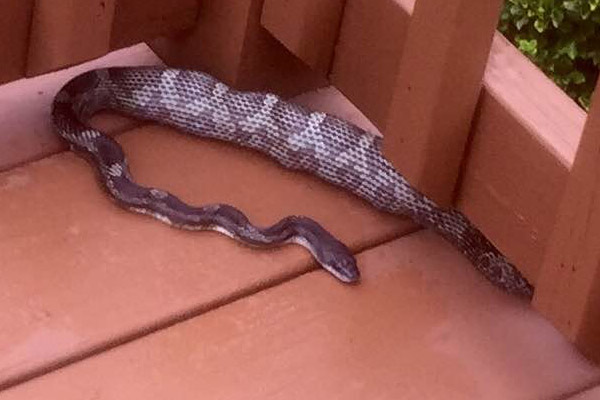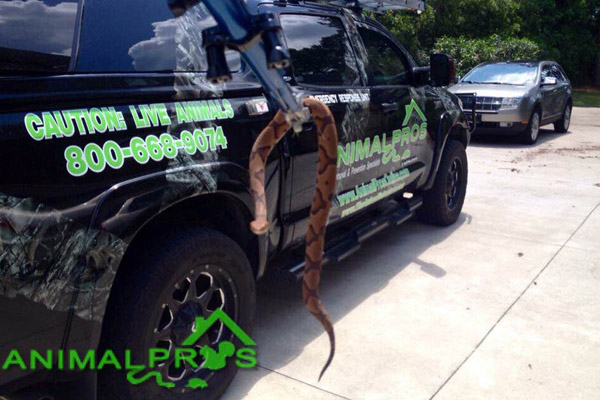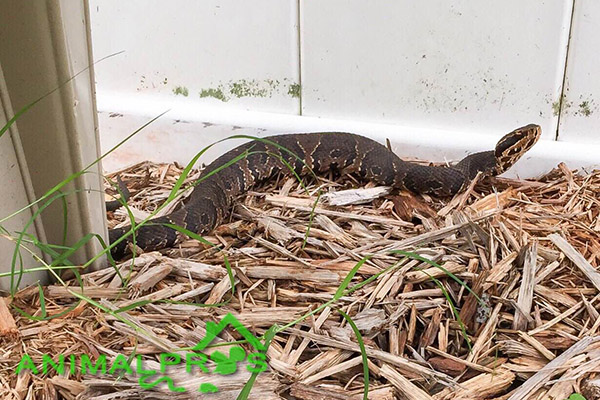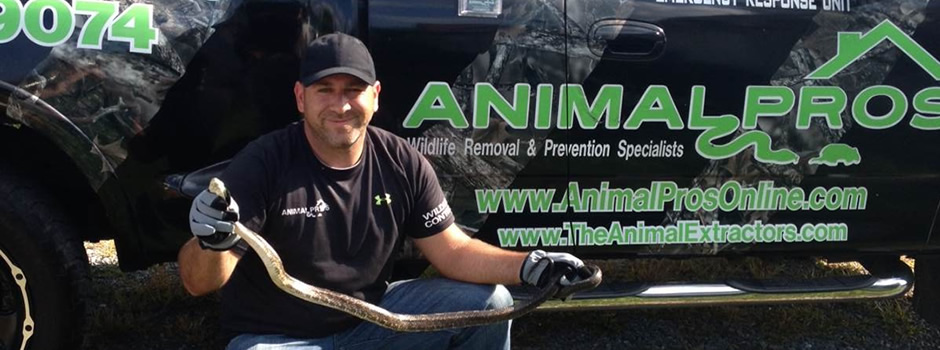Indianapolis Snake Removal
Animal Pros ~ 317-559-4044
Indiana is home to 34 species of snakes, and of the 34, only 4 are venomous. Indianapolis does have some venomous snakes, usually around the outer areas of Indianapolis Metro, Davidson, Sumner, Robertson, Rutherford, Williamson, and Wilson County areas. For questions or help with Snake identification, please use this page as a reference or text 24/7 (615)-613-5992 for identification. For Snake Removal in Indianapolis area wide please call us immediately.
Indiana Snake Regulations
In Indiana, it is illegal to kill, harm, remove from the wild, or possess snakes taken from the wild, without proper permits. Do not try to kill, handle, or catch snakes. Do not release captive snakes into the wild. Always contact a professional for immediate snake identification, snake removal, snake control, or contact a ER if you have been bitten by a snake. There is no need to bring the snake to the ER if venomous, as all venomous snakes in Indiana are pit vipers and the anti-venom is the same.
Snakes In Your Home
 The presence of snake activity in your home can seem like a nightmare for any homeowner. Thoughts of snakes slithering around a home can be very unsettling. First of all, Snakes are excellent climbers. Snakes will not be confined to low foundation openings, but can and will take advantage of trees, bushes, and limbs overlapping your roof line, use mortar lines in between brick to move up your home, and gutter spouts to climb higher to access attic openings. Snakes often will enter homes high and low if there are openings, to seek out a food source. By food source, usually mice, rats, birds, and squirrels. Body oils that rub off a animals fur that are using your home as shelter, is all a snake needs to follow scent markings, attractants, and trails, right to the same exact opening the animal has been. Once the snake is inside the home, it will follow those same trails through insulation in attics, walls, or even into the crawlspace to search out the food source. Have you ever seen a mouse run across a floor? If your one of the homeowners who have came home to a snake in your floor, this is how that happens. Contact our Snake Removal Specialists at Animal Pros for further information on snake control for your home.
The presence of snake activity in your home can seem like a nightmare for any homeowner. Thoughts of snakes slithering around a home can be very unsettling. First of all, Snakes are excellent climbers. Snakes will not be confined to low foundation openings, but can and will take advantage of trees, bushes, and limbs overlapping your roof line, use mortar lines in between brick to move up your home, and gutter spouts to climb higher to access attic openings. Snakes often will enter homes high and low if there are openings, to seek out a food source. By food source, usually mice, rats, birds, and squirrels. Body oils that rub off a animals fur that are using your home as shelter, is all a snake needs to follow scent markings, attractants, and trails, right to the same exact opening the animal has been. Once the snake is inside the home, it will follow those same trails through insulation in attics, walls, or even into the crawlspace to search out the food source. Have you ever seen a mouse run across a floor? If your one of the homeowners who have came home to a snake in your floor, this is how that happens. Contact our Snake Removal Specialists at Animal Pros for further information on snake control for your home.
Snakes In Your Yard
Seeing Snakes in your yard may not be a need of panic. Best thing to do is leave the snake alone as it is just passing by. Snakes are put here for a reason and they do their fair share of controlling rodent populations. But if the snake does come up around the home, gets too close to children or pets removal may be necessary. Evaluate what is exactly the cause. Are there bird nests in the shrubs and trees around your home? Is there debris and shelter, or over growth of vegetation creating a suitable habitat? Is there a rodent problem in your attic or crawlspace? Is there building and construction happening close by? These are all reasons why snakes might inhibit your property, and take up refuge. To see the various types of snakes in Indianapolis, see our snake identification page.
Snake Control Indianapolis
If you are in need of Snake Control in Indianapolis area wide, then you should contact us today. A Snake Search is performed identifying the presence of Snakes, Snake Skins, Snake Droppings, the food source the Snakes are after, and openings the Snakes may be using to gain access into your home. Contact our Snake Removal and Control Specialists today for all questions and confers of snake problems in Indiana, and Indianapolis area wide. 317-559-4044.
We handle Snake Removal to Indianapolis, Franklin, Brentwood, Hendersonville, Murfreesboro, Smyrna, Columbia, Spring Hill, Thompson’s Station, Lebanon, Mt Juliet, Gallatin, Goodlettsville, White House, Portland, Cross Plains, Orlinda, Springfield, Pleasant View, Ashland City, Pegram, La Vergne, Dickson, Centerville, Kingston Springs, Arrington, Indiana
We also take care of the following counties: Davidson County, Sunmer County, Williamson County, Robertson County, Rutherford County, Wilson County, Maury County, Dickson County, Hickman County, Montgomery County, and Cheatham County.
Indianapolis Snakes in Attic
Snake activity in Indiana, or Indianapolis area wide really starts occurring in late March through early November. Most Snake bites occur April – October in Indiana. But with Indiana having 40 degree temperature changes in a given day, you can have snake activity nearly year round. Snakes can be diurnal and seen mostly during the day as temperatures warm, but snakes can be nocturnal, especially when temperatures are conducive, or moving in and out of a home. We have commonly entered attics with multiple live snakes, removed them, searched for more, only to return the next day to find more live snakes. Mating Season of snakes vary by species, and can occur April – September, and by area.
Snake Behavior
Snake calls that pour in on a daily basis, indicate a Rattlesnake or Copperhead, when in 99.9% of the cases it is a non venomous snake. Did you know that most non venomous snakes will rattle their tail or whip it back and fourth as a defense mechanism, making a rattle noise. Any snake can be aggressive, and snakes should all be treated with respect. If you are unsure, treat it as a venomous snake and keep your distance. Snakes will frequent residential areas in search of food sources like, frogs, toads, fish, chipmunks, mice, rats, birds, squirrels, and even bats, especially if you have any of these living in your home.
Understanding Snake Problems
Snakes are incredibly good at finding a food source. If you have ever seen a snake flickering its tongue, it is tasting the air. Once a snake brings his tongue back into its mouth, scent particles in the air are pushed up to a organ on the roof of the mouth, letting that snake know if its prey, or to be afraid. The Vomeronasal organ or Jacobson’s organ is used in snakes to pick up scent marking of prey. It is these same scent marking leading a snake directly to the opening of a home a rodent may be using, turning a mice problem to a mice and snake problem.
Indianapolis Snake Trapping
There are a number of Snake Traps on the market, and very few that are effective. The best way to remove a snake, is to have a professional remove it as soon as it is seen. Having a professional search for a snake that was seen last week is like searching for a needle in a haystack. We do offer Snake Trapping in certain situations if necessary and trap placement and what is put in the trap is key. Contact us today for help with Snake Trapping in Indianapolis area wide.
How To Get Rid Of Snakes:
- Is there a Rodent, Squirrel, or Bird Problem in or around your home?
- Is there openings around your foundation or roofline?
- Do Tree’s overlap your roof?
- Are you noticing frequent snake sightings?
- Have you found snake skins, snake droppings, or areas where snakes are often found?
- Is there yard debris, or a abundance of over growth?
The answers to many of these problems will be addressed and evaluated by our Animal Pros snake specialists, as we can provide a long lasting permanent solution.
Non Venomous Snakes of Indiana

Rat Snake
Grey Rat Snake – Often referred to as the chicken snake or black snake, is the most common snake found to enter homes. They are excellent climbers, and can even use mortar lines in between bricks to gain access into a home. The biggest threat this snake will cause is the injury if you trip while running away.
Venomous Snakes in Indiana
 There are 4 species of venomous snakes in Indiana including the Timber Rattlesnake, Copperhead, Water Moccasin, and the Pigmy Rattlesnake.
There are 4 species of venomous snakes in Indiana including the Timber Rattlesnake, Copperhead, Water Moccasin, and the Pigmy Rattlesnake.
All are pit vipers containing the heat seeking pit located between the eye and nostril. While many snakes are mistaken for being venomous, they may resemble or mimic actions of a venomous snake.
Timber Rattlesnake

Timber Snake
The Timber Rattlesnake or (Canebrake Rattlesnake) can on average grow between 35″ and 60″ long. Average weight of a Timber Rattlesnake can be between on average 1-3 lbs, with some large specimens reaching nearly 10lbs. They are usually active between March through October, but depending on geographical location and warmer temperatures, can still be active on winter days. Timber Rattlesnakes give birth between August through late September to live young and can have as many as 14 young. They ares capable of living in the wild 12 years to as many as 30 years, and typically will den up or congregate during winter. Typical food sources of the Timber Rattlesnake can consist of small mammals, including squirrels, birds, amphibians, and even other snakes. Usually shedding its skin every year a new rattle segment will grow, or button on its rattle. The venom of the Timber Rattlesnake is used to immobilize prey, but can be fatal to people if a untreated bite occurs. Venom of a rattlesnake stops blood from clotting, and can destroy tissue and organs. If you happen to be struck, seek medical attention immediately.
Copperhead

Copperhead
Copperheads are well known from their copper appearance and colorations, as well as being the most responsible for occuring snake bites. Most bites occur when the snake is stepped on or near, and may be a dry bite where very little to no venom is injected. Most bites are a reaction strike, and Copperheads will not hesitate to strike. Their copper patterns can make them incredibly hard to spot among leaves as they blend right in. Adults can measure 2-3 ft, as some can be longer. They are usually active between February – October, and mating occurs between February to May and again in late fall from August to October. Copperheads can have between 2-18 young usually a grayer color. Young Copperheads are born with a bright yellow tail, and as they lay motionless, can flick the tail giving off the apperance of a caterpillar (Caudal Luring) for a unsuspecting lizard or frog. Copperheads can live as many as 20 years in the wild.
Water Moccasin

Water Moccasin
The Water Moccasin or (Cottonmouth) is widely known for its white mouth as it opens warning someone that they are too close and it will bite. Water Moccasins typically range between 31″ to 70″ in length, and can weigh up to 10lbs. Although coloration may be totally black, they can range in colors from tan, olive, brown, yellowish, or grey patterns. Water Moccasins are the most aquatic venomous snake ofter being found near or close to water. They give birth to live young and can range from 1 to as many as 20 young during August through October, although mating can occur during any of the warmer months. They mostly feed on fish, reptiles, amphibians, small mammals, birds, and will feed on other snakes, even their own kind. Water Moccasins can be active almost year round, as they are the last snake species to den up in winter. They also happen to have the reptation for being the most aggressive.
Pigmy Rattlesnake

Pygmy Rattlesnake
The Pigmy Rattlesnake has a very small rattle compared to other rattlesnakes which can seldomly be heard and it blends in with ground cover exceptionally well. They only average between 14″ an 30″ in length. They are active March through October and can give live birth to 3-8 young.
Preferred foods of the Pygmy tend to be lizards, frogs, and small rodents. Do not let their size fool you. They will act much larger and can be aggressive. With heat sensory pits it allows the snake to detect and accurately strike warm bodied prey.
Snake Repellents
 Snake Repellents are more often ineffective by itself. There are several different snake repellents on the market, and few can be effective only in addition to other Snake Control options. Separating Facts from Myths is crucial. Fact, Moth Balls are ineffective. Not only do Moth Balls not work, they are bad for the environment. Snake Repellents come in spray, liquid, and powder form. For a Snake Repellent to be effective, debris or shelter for snakes must be removed or habitat modified. The food source snakes are after must be eliminated. Openings in or around your home must be secured. The other factors that can effect longevity of Snake Repellents can be weather. How much rain does the area receive, is it the rain or flooding season, does the area hold a lot of moisture. There are several safety precautions when using Snake Repellents, so the best thing to do is contact one of our professionals for further assistance.
Snake Repellents are more often ineffective by itself. There are several different snake repellents on the market, and few can be effective only in addition to other Snake Control options. Separating Facts from Myths is crucial. Fact, Moth Balls are ineffective. Not only do Moth Balls not work, they are bad for the environment. Snake Repellents come in spray, liquid, and powder form. For a Snake Repellent to be effective, debris or shelter for snakes must be removed or habitat modified. The food source snakes are after must be eliminated. Openings in or around your home must be secured. The other factors that can effect longevity of Snake Repellents can be weather. How much rain does the area receive, is it the rain or flooding season, does the area hold a lot of moisture. There are several safety precautions when using Snake Repellents, so the best thing to do is contact one of our professionals for further assistance.

